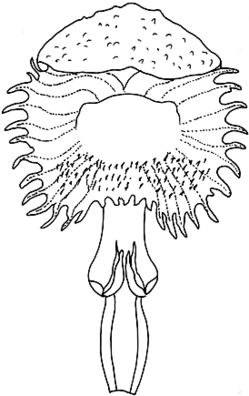Corybas longitubus (D.L.Jones & L.M.Copel.) M.A.M.Renner APNI* Synonyms: Corysanthes longituba D.L.Jones & L.M.Copel. APNI*
Corybas sp. A sensu Harden (1993) APNI*

Description: Terrestrial herb.
Leaf 8–22 mm long, 8–25 mm wide, upper surface green, lower surface pellucid.
Flower erect, pale reddish pink and white, 12–16 mm long. Dorsal sepal obovate, cucullate, 20–26 mm long, 9–11 mm wide, greyish with reddish striations. Lateral sepals linear, tapered, c. 2 mm long. c. 0.3 mm wide, fused at the base. Petals linear, falcate, c. 1.5 mm long, c. 0.4 mm wide, auriculate at the base. Labellum tube longer than the lamina, erect; lamina flared widely, nearly circular, 10–12 mm long, 11–14 mm across, the margins spreading, with numerous triangular teeth; boss cream, mounded; auricles oblique, the opening c. 0.7 mm across.
Flowering: September–November
Distribution and occurrence: Grows in wet habitats close to streams or in Sphagnum mounds; apparently restricted to the Barrington Tops.
NSW subdivisions: NT
Text by D. L. Jones
Taxon concept: Flora of NSW 4 (1993), and Jones DL, Copeland LM (2018) Corysanthes longituba (Orchidaceae: Acianthiinae), a new species from northern New South Wales. Australian Orchid Review 83: 56–57.
APNI* Provides a link to the Australian Plant Name Index (hosted by the Australian National Botanic Gardens) for comprehensive bibliographic data
***The AVH map option provides a detailed interactive Australia wide distribution map drawn from collections held by all major Australian herbaria participating in the Australian Virtual Herbarium project.
|


